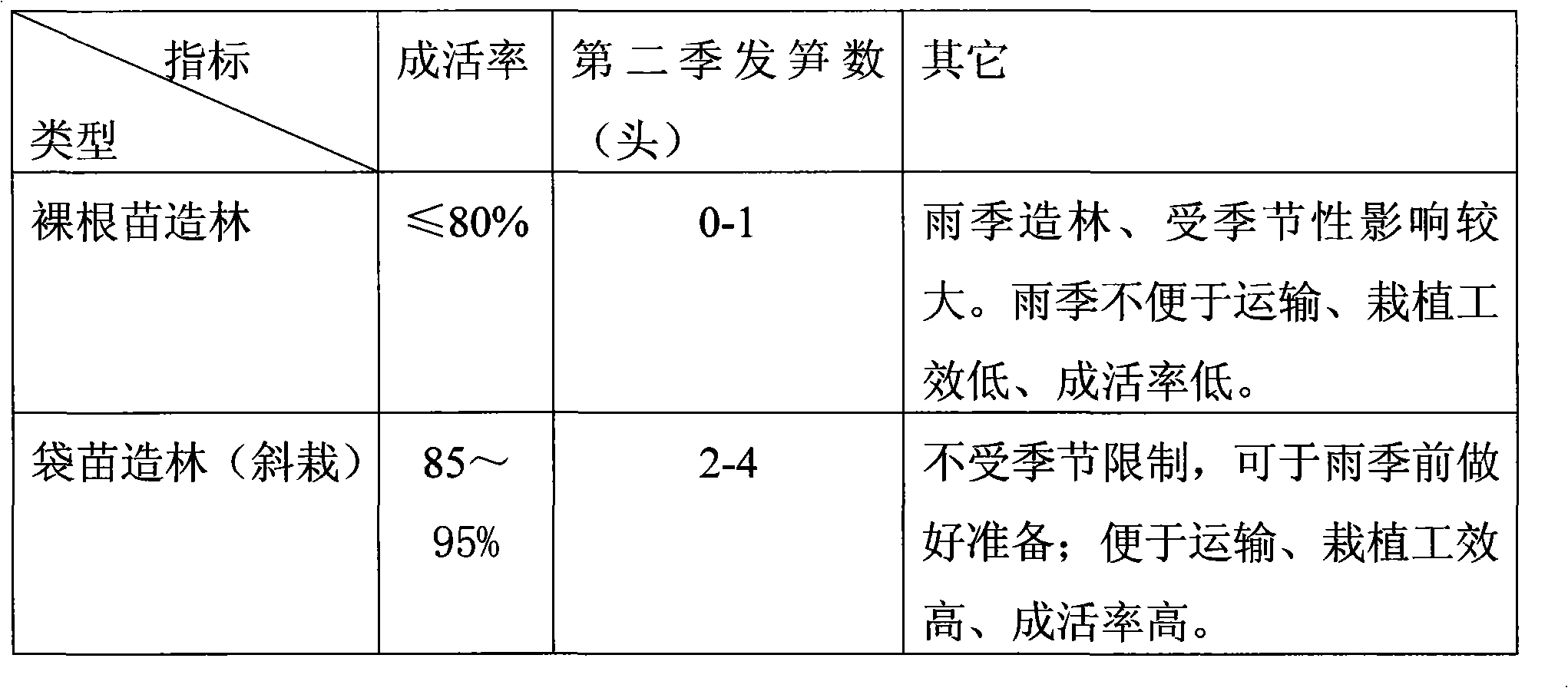Large-scale forestation method of nutrient pot seedlings of sympodial bamboos
A nutrient bowl, large-scale technology, applied in the field of afforestation of large cluster bamboo nutrient pot seedlings, can solve the problems of high cost, inability to meet the rainy season afforestation, low survival rate and preservation rate of bare-root seedling afforestation, and achieve a strong superior effect
- Summary
- Abstract
- Description
- Claims
- Application Information
AI Technical Summary
Problems solved by technology
Method used
Image
Examples
Embodiment 1
[0018] Embodiment 1 nutrient pot seedling afforestation (oblique planting)
[0019] Follow the steps below to implement:
[0020] 1. The season for afforestation of large clustered bamboos is from March to July every year.
[0021] 2. The clearing of the forest land mainly cuts down all the small miscellaneous shrubs, weeds, big awns, vines, etc. in the forestation land, and the height of the felling pile is required to be ≤ 10 cm;
[0022] 3. The distribution of points shall be carried out according to the requirement that the spacing between plants and rows is 5 meters × 8 meters.
[0023] 4. Hole opening specification requirements
[0024] The length is 50 cm, the width is 40 cm, and the depth is 30 cm. The dimensions are all measured by the mouth of the acupoint. Before opening the hole, take the opening point as the center, shovel the weeds within a radius of 75 cm, pile the topsoil under the hole opening, and pile the core soil on either side of the hole opening. Afte...
Embodiment 2
[0031] Embodiment 2 (bare root seedling afforestation)
[0032] In embodiment 1, in step 5, the transport of seedlings in the afforestation site must be carried manually, and the seedlings are transported with pockets, and placed uniformly above the planting holes.
[0033] In embodiment 1, in step 6, according to the size of the container seedling and the length of the bamboo seedling stalk, the seedlings are planted in the center of the hole along the edge, and the moist fine soil in the hole is used to plug around the roots of the seedlings tightly, and then the core soil next to the hole is covered. Slightly compact the seedling stalks, and shovel back the surrounding surface fertile soil if the backfill is insufficient. The covering soil is slightly higher than the pond mouth, and the outside is high and the inside is low, but no low-lying water.
[0034] Steps (1), (2), (3), (4), (7) are the same as in Example 1.
[0035] Technical effect of the present invention is as ...
PUM
 Login to View More
Login to View More Abstract
Description
Claims
Application Information
 Login to View More
Login to View More - R&D
- Intellectual Property
- Life Sciences
- Materials
- Tech Scout
- Unparalleled Data Quality
- Higher Quality Content
- 60% Fewer Hallucinations
Browse by: Latest US Patents, China's latest patents, Technical Efficacy Thesaurus, Application Domain, Technology Topic, Popular Technical Reports.
© 2025 PatSnap. All rights reserved.Legal|Privacy policy|Modern Slavery Act Transparency Statement|Sitemap|About US| Contact US: help@patsnap.com

